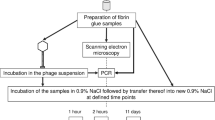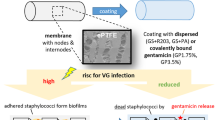Abstract
We investigated whether fibrin glue (FG) might be useful as a carrier of amikacin (AMK) for prevention of local graft infection. After AMK (4.0 mg)-treated FG (AMK-FG) polyurethane grafts were implanted subcutaneously in the anterior abdominal region of Sprague-Dawley rats, AMK concentrations in tissues surrounding the implantation sites were compared over time with concentrations at the same sites in rats given an intravenous injection of AMK (4.0 mg). In the injection group, AMK concentrations in serum were detectable only for 4 h, whereas AMK released from AMK-FG grafts remained detectable over 24 h. Until 4 h after implantation, AMK concentrations in tissues near implantation sites were significantly higher in the AMK-FG graft group than in the injection group; peak local concentrations during that time were 210 times higher for the AMK-FG graft group than for the injection group. Areas under the tissue concentration–time curve (AUC) for AMK were 171 µg·h/g and 1.35 µg·h/g in the AMK-FG graft and injection groups, respectively. FG therefore was considered to control release of AMK and to maintain a high AMK concentration in tissues surrounding the implantation site. Thus, AMK-FG polyurethane graft delivery may be useful in preventing local infection by local delivery of AMK.
Similar content being viewed by others
Author information
Authors and Affiliations
Corresponding author
About this article
Cite this article
Nishimoto, K., Yamamura, K., Fukase, F. et al. Subcutaneous tissue release of amikacin from a fibrin glue/polyurethane graft. J Infect Chemother 10, 101–104 (2004). https://doi.org/10.1007/s10156-004-0304-8
Received:
Accepted:
Issue Date:
DOI: https://doi.org/10.1007/s10156-004-0304-8




